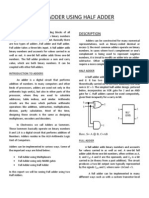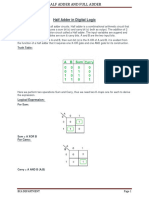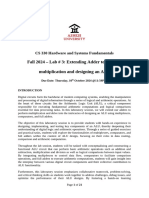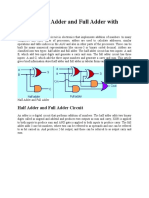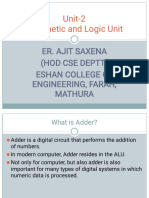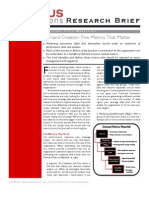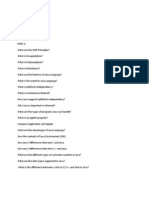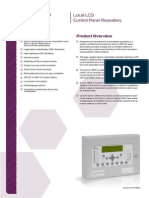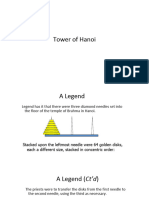ALU unit
ALU unit
Uploaded by
mrhandsomboy998Copyright:
Available Formats
ALU unit
ALU unit
Uploaded by
mrhandsomboy998Copyright
Available Formats
Share this document
Did you find this document useful?
Is this content inappropriate?
Copyright:
Available Formats
ALU unit
ALU unit
Uploaded by
mrhandsomboy998Copyright:
Available Formats
COMPUTER ORGANIZATION
Arithmetic and logic Unit (ALU)
ALU is responsible to perform the operation in the computer.
The basic operations are implemented in hardware level. ALU is having collection of two types of
operations:
Arithmetic operations
Logical operations
Consider an ALU having 4 arithmetic operations and 4 logical operation.
To identify any one of these four logical operations or four arithmetic operations, two control lines are
needed. Also to identify the any one of these two groups- arithmetic or logical, another control line is
needed. So, with the help of three control lines, any one of these eight operations can be identified.
Consider an ALU is having four arithmetic operations. Addition, subtraction, multiplication and division.
Also consider that the ALU is having four logical operations: OR, AND, NOT & EX-OR.
We need three control lines to identify any one of these operations. The input combination of these
control lines are shown below:
Control line is used to identify the group: logical or arithmetic, ie
: arithmetic operation : logical operation.
Control lines and are used to identify any one of the four operations in a group. One possible
combination is given here.
A decode is used to decode the instruction. The block diagram of the ALU is shown in figure 2.1.
G.Vijay Kumar, CSE dept, AITAM 1
COMPUTER ORGANIZATION
Figure 2.1: Block Diagram of the ALU
The ALU has got two input registers named as A and B and one output storage register, named as C. It
performs the operation as:
C = A op B
The input data are stored in A and B, and according to the operation specified in the control lines, the
ALU perform the operation and put the result in register C.
As for example, if the contents of controls lines are, 000, then the decoder enables the addition operation
and it activates the adder circuit and the addition operation is performed on the data that are available in
storage register A and B . After the completion of the operation, the result is stored in register C.
We should have some hardware implementations for basic operations. These basic operations can be
used to implement some complicated operations which are not feasible to implement directly in hardware.
There are several logic gates exists in digital logic circuit. These logic gates can be used to implement the
logical operation. Some of the common logic gates are mentioned here.
AND gate: The output is high if both the inputs are high. The AND gate and its truth table is shown in
Figure 2.2.
Figure 2.2: AND gate and its truth table.
G.Vijay Kumar, CSE dept, AITAM 2
COMPUTER ORGANIZATION
OR gate: The output is high if any one of the input is high. The OR gate and its truth table is shown in
Figure 2.3.
Figure 2.3: OR gate and its truth table.
EX-OR gate: The output is high if either of the input is high. The EX-OR gate and its truth table is given
in Figure 2.4.
Figure 2.4: EX-OR gate and its truth table.
If we want to construct a circuit which will perform the AND operation on two 4-bit number, the
implementation of the 4-bit AND operation is shown in the Figure-2.5.
Figure2.5: 4-bit AND operator
G.Vijay Kumar, CSE dept, AITAM 3
COMPUTER ORGANIZATION
Arithmetic Circuit
Binary Adder :
Binary adder is used to add two binary numbers.
In general, the adder circuit needs two binary inputs and two binary outputs. The input variables designate
the augends and addend bits; The output variables produce the sum and carry.
The binary addition operation of single bit is shown in the truth table
C: Carry Bit
S: Sum Bit
The simplified sum of products expressions are
The circuit implementation is
Figure 2.6: Circuit diagram and Block diagram of Half Adder
This circuit can not handle the carry input, so it is termed as half adder.The circuit diagram and block
diagram of Half Adder is shown in Figure 2.6.
Full Adder:
A full adder is a combinational circuit that forms the arithmetic sum of three bits. It consists of three
inputs and two outputs.
Two of the input variables, denoted by x and y, represent the two bits to be added. The third input Z,
represents the carry from the previous lower position.
G.Vijay Kumar, CSE dept, AITAM 4
COMPUTER ORGANIZATION
The two outputs are designated by the symbols S for sum and C for carry.
The simplified expression for S and C are
We may rearrange these two expressions as follows:
The circuit diagram full adder is shown in the figure.
Figure 2.7: Circuit diagram and block diagram of Full Adder
The circuit diagram and block diagram of a Full Adder is shown in the Figure 2.7. n-such single bit full
adder blocks are used to make n-bit full adder.
G.Vijay Kumar, CSE dept, AITAM 5
COMPUTER ORGANIZATION
To demonstrate the binary addition of four bit numbers, let us consider a specific example.
Consider two binary numbers
A =1 0 0 1 B=0011
To get the four bit adder, we have to use 4 full adder block. The carry output the lower bit is used as a
carry input to the next higher bit.
The circuit of 4-bit adder shown in the Figure 2.8.
Figure 2.8: A 4-bit adder circuit.
Binary Subtractor :
The subtraction operation can be implemented with the help of binary adder circuit, because
We know that 2's complement representation of a number is treated as a negative number of the given
number.
We can get the 2's complements of a given number by complementing each bit and adding 1 to it.
The circuit for subtracting A-B consist of an added with inverter placed between each data input B and the
G.Vijay Kumar, CSE dept, AITAM 6
COMPUTER ORGANIZATION
corresponding input of the full adder. The input carry must be equal to 1 when performing subtraction.
The operation thus performed becomes A , plus the 1's complement of B , plus 1. This is equal to A plus
2's complement of B .
With this principle, a single circuit can be used for both addition and subtraction. The 4 bit adder
subtractor circuit is shown in the figure. It has got one mode ( M ) selection input line, which will
determine the operation,
If , then
If then
1's complement of
Figure 2.9: 4-bit adder subtractor
The circuit diagram of a 4-bit adder substractoris shown in the Figure 2.9.
The operation of OR gate:
if
if
Multiplication
Multiplication of two numbers in binary representation can be performed by a process of SHIFT and
ADD operations. Since the binary number system allows only 0 and 1's, the digit multiplication can be
replaced by SHIFT and ADD operation only, because multiplying by 1 gives the number itself and
multiplying by 0 produces 0 only.
The multiplication process is illustrated with a numerical example.
G.Vijay Kumar, CSE dept, AITAM 7
COMPUTER ORGANIZATION
The process consists of looking at successive bits of the multiplier, least significant bit first. If the
multiplier bit is a 1, the multiplicand is copied down, otherwise, zeros are copied down. The numbers
copied down in successive lines are shifted one position to the left from the previous number. Finally, the
numbers are added and their sum forms the product.
When multiplication is implemented in a digital computer, the process is changed slightly.
Instead of providing registers to store and add simultaneously as many binary numbers as there are bits in
the multiplier, it is convenient to provide an adder for the summation of only two binary numbers and
successively accumulate the partial products in a register. It will reduce the requirements of registers.
Instead of sifting the multiplicand to the left, the partial product is shifted to right.
When the corresponding bit of the multiplier is 0, there is no need to add all zeros to the partial product.
An algorithm to multiply two binary numbers. Consider that the ALU does not provide the multiplication
operation, but it is having the addition operation and shifting operation. Then we can write a micro
program for multiplication operation and provide the micro program code in memory. When a
multiplication operation is encountered, it will execute this micro code to perform the multiplication.
The micro code is nothing but the collection of some instructions. ALU must have those operation;
otherwise we must have micro code again for those operations which are not supported in ALU.
Consider a situation such that we do not have the multiplication operation in a primitive computer. Is it
possible to perform the multiplication. Of course, yes, provided the addition operation is available.
We can perform the multiplication with the help of repeated addition method; for example, if we want to
multiply 4 by 5 ( 4 5), then simply add 4 five times to get the result.
If it is possible by addition operation, then why we need a multiplication operation.
Consider a machine, which can handle 8 bit numbers, then we can represent number from 0 to 255. If we
want to multiply 175 225, then there will be at least 175 addition operation.
G.Vijay Kumar, CSE dept, AITAM 8
COMPUTER ORGANIZATION
But if we use the multiplication algorithm that involves shifting and addition, it can be done in 8 steps,
because we are using an 8-bit machine.
Again, the micro program execution is slightly slower, because we have to access the code from micro
controller memory, and memory is a slower device than CPU.
It is possible to implement the multiplication algorithm in hardware.
Binary Multiplier, Hardware Implementation
The block diagram of binary multiplier is shown in the Figure 2.10..
Figure 1.10: Block diagram of binary multiplier
The multiplicand is stored in register B and the multiplier is stored in register Q.
The partial product is formed in register A and stored in A and Q
The counter P is initially set to a number equal to the number of bits in the multiplier. The counter is
decremented by 1 after forming each partial product. When the content of the counter reaches zero, the
product is formed and the process stops.
Initially, the multiplicand is in register B and the multiplier in Q. The register A is reset to 0.
The sum of A and B forms a partial product- which is transferred to the EA register.
Both partial product and multiplier are shifted to the right. The least significant bit of A is shifted into the
most significant position of Q; and 0 is shifted into E.
After the shift, one bit of the partial product is shifted into Q, pushing the multiplier bits one position to
the right.
The right most flip flop in register Q, designated by Q0 will hold the bit of the multiplier which must be
inspected next. If the content of this bit is 0, then it is not required to add the multiplicand, only shifting is
needed. If the content of this bit is 1, then both addition and shifting are needed.
G.Vijay Kumar, CSE dept, AITAM 9
COMPUTER ORGANIZATION
After each shifter, value of counter P is decremented and the process continues till the counter value
becomes 0.
The final result is available in ( EAQ ) registers combination.
To control the operation, it is required to design the appropriate control logic that is shown in the block
diagram.
The flow chart of the multiplication operation is given in the Figure 2.11.
Figure 2.11: Flow chart of the multiplication operation
G.Vijay Kumar, CSE dept, AITAM 10
COMPUTER ORGANIZATION
The working of multiplication algorithm is shown here with the help of an example.
Multiplicand
G.Vijay Kumar, CSE dept, AITAM 11
You might also like
- DFA TemplateDocument28 pagesDFA TemplateVedant KashyapNo ratings yet
- Assignment Unit 3 - With AnswerDocument6 pagesAssignment Unit 3 - With AnswereuanaresNo ratings yet
- Practical-1 AIM: Implement Register Transfer Operation in Logisim SimulatorDocument23 pagesPractical-1 AIM: Implement Register Transfer Operation in Logisim SimulatorDigvijay Sinh ChauhanNo ratings yet
- OPICDocument32 pagesOPICTasha100% (1)
- Arithmetic and Logic Unit (ALU) : ALU Is Responsible To Perform The Operation in The ComputerDocument13 pagesArithmetic and Logic Unit (ALU) : ALU Is Responsible To Perform The Operation in The ComputerSAFI ULLAH KHANNo ratings yet
- AluDocument10 pagesAluAbhishek PatraNo ratings yet
- Arithmetic and Logic Unit (ALU) PDFDocument13 pagesArithmetic and Logic Unit (ALU) PDFnathulalusaNo ratings yet
- Arithmetic and Logic UnitDocument9 pagesArithmetic and Logic UnitleevasusanNo ratings yet
- Unit 2 ALU Part 1Document7 pagesUnit 2 ALU Part 1ImranNo ratings yet
- Lab Report #5 by MungunsukhDocument7 pagesLab Report #5 by MungunsukhoyunpurevoyunaaNo ratings yet
- Chapter IIb Arithmetic CircuitsDocument9 pagesChapter IIb Arithmetic CircuitsEmperor'l BillNo ratings yet
- 5EC3-01: Computer Architecture: UNIT-2Document17 pages5EC3-01: Computer Architecture: UNIT-2Himanshi SainiNo ratings yet
- Unit_2Document22 pagesUnit_2anubhav.2327it1128No ratings yet
- Fig.2 Functional Representation of Arithmetic Logic UnitDocument7 pagesFig.2 Functional Representation of Arithmetic Logic Unitsamfear60No ratings yet
- Digital Electronics Module 04Document25 pagesDigital Electronics Module 04kzrdur100% (1)
- Design of Efficient Multiplier Using VHDLDocument50 pagesDesign of Efficient Multiplier Using VHDLNagendra KashyapNo ratings yet
- BIT102 SLM Library - SLM - Unit 07Document23 pagesBIT102 SLM Library - SLM - Unit 07pavanmay227597No ratings yet
- Adder SubtractorDocument23 pagesAdder SubtractorPARTEEK RANANo ratings yet
- Binary Adder: A Full Adder CircuitDocument8 pagesBinary Adder: A Full Adder CircuitSejal KankriyaNo ratings yet
- DT MPDocument21 pagesDT MPKaiwalya MatreNo ratings yet
- Full Adder Using Half AdderDocument4 pagesFull Adder Using Half AdderNiraj Shetty100% (1)
- Explanation of Half Adder and Full Adder With Truth TableDocument13 pagesExplanation of Half Adder and Full Adder With Truth TableDeepikaNo ratings yet
- Module 3Document47 pagesModule 3beebeefathimabagum435No ratings yet
- Project Report About MultipliersDocument62 pagesProject Report About Multiplierssenthilvl80% (5)
- Unit2 2Document35 pagesUnit2 2npradeepjiNo ratings yet
- Chapter 3 Combinational CircuitsDocument22 pagesChapter 3 Combinational Circuitsabhijitshinde989sNo ratings yet
- ADDERDocument5 pagesADDERRam samplaNo ratings yet
- COA - Experiment No 04-Half Full AdderDocument7 pagesCOA - Experiment No 04-Half Full AdderSakshi Shailendra GoleNo ratings yet
- CS Fall HSF Lab 3Document21 pagesCS Fall HSF Lab 3eddiemens0462No ratings yet
- Half Adder and Full AdderDocument6 pagesHalf Adder and Full AdderGreat OhaekwusiNo ratings yet
- IJECCE 839 FinalDocument4 pagesIJECCE 839 Finalsudip mandalNo ratings yet
- Unit 4Document13 pagesUnit 421embit027No ratings yet
- Dayalbagh Educational Institute: Experiment 1-To Implement Half Adder by Using Basic and UniversalDocument41 pagesDayalbagh Educational Institute: Experiment 1-To Implement Half Adder by Using Basic and UniversalKhushi GuptaNo ratings yet
- Experiment No 8Document12 pagesExperiment No 8alishabutt23355No ratings yet
- EXP6Document2 pagesEXP6Ivan Matala100% (1)
- DL Unit 7Document27 pagesDL Unit 7wbtyjqgg9No ratings yet
- CMOS Based Design Simulation of Adder /subtractor Using Different FoundriesDocument7 pagesCMOS Based Design Simulation of Adder /subtractor Using Different FoundriesRavindra KumarNo ratings yet
- DEC Report 4 (C)Document11 pagesDEC Report 4 (C)S M Akash100% (1)
- combination circuits in computer engineeringDocument19 pagescombination circuits in computer engineeringDashamoolam DhamuNo ratings yet
- CHAPTERDocument47 pagesCHAPTERNIKHIL PUJARINo ratings yet
- Adder MeenuDocument52 pagesAdder Meenunaidukoduru2002No ratings yet
- Adder CircuitDocument25 pagesAdder Circuitsenpaixd0110No ratings yet
- Introduction To Digital System Laboratory PDFDocument32 pagesIntroduction To Digital System Laboratory PDFAdhitya Rahman100% (1)
- Da 2 DCSDocument6 pagesDa 2 DCSKumar ReaturajNo ratings yet
- Half Adder BAsics, Full Adder BAsicsDocument15 pagesHalf Adder BAsics, Full Adder BAsicsz33sha9No ratings yet
- Vlsi 3Document10 pagesVlsi 3NIKHIL PUJARINo ratings yet
- How Addition WorksDocument3 pagesHow Addition WorksetbalanseNo ratings yet
- Adder SubtractorDocument15 pagesAdder Subtractormellonera219No ratings yet
- Co-Unit 6Document19 pagesCo-Unit 6Priyanka H VNo ratings yet
- Experiment 8Document5 pagesExperiment 8vkrNo ratings yet
- Coa - Unit 4Document30 pagesCoa - Unit 4vishnuchandranrvNo ratings yet
- DSD Lab 06Document9 pagesDSD Lab 06Mohib HaroonNo ratings yet
- Implementation of A High Speed Single Precision Floating Point Unit Using VerilogDocument5 pagesImplementation of A High Speed Single Precision Floating Point Unit Using VerilogVikas PakhretiaNo ratings yet
- Adder ReportDocument4 pagesAdder ReportSajid AliNo ratings yet
- Adder and SubtractorDocument7 pagesAdder and SubtractorMuddassar AliNo ratings yet
- Complete COA 2nd UnitDocument97 pagesComplete COA 2nd UnitishitaNo ratings yet
- Combinational Circuits DesignDocument32 pagesCombinational Circuits DesignRudra ChauhanNo ratings yet
- Co Unit-5Document20 pagesCo Unit-5moseslovely10commandsNo ratings yet
- Chapter 8: Micro-Operations: ObjectivesDocument5 pagesChapter 8: Micro-Operations: ObjectivesSteffany RoqueNo ratings yet
- 52 Yash Thakur (DLCA) Experiment No 5Document5 pages52 Yash Thakur (DLCA) Experiment No 5nisha maskeNo ratings yet
- The Elements of Computing Systems, second edition: Building a Modern Computer from First PrinciplesFrom EverandThe Elements of Computing Systems, second edition: Building a Modern Computer from First PrinciplesNo ratings yet
- Big Data MBA Driving Business Strategies With Data Science 1st Edition 2015 Wiley (PRG)Document44 pagesBig Data MBA Driving Business Strategies With Data Science 1st Edition 2015 Wiley (PRG)Caleb Terrel OrellanaNo ratings yet
- Gallien Krueger Fusion 550 Manuel Utilisateur en 29055Document12 pagesGallien Krueger Fusion 550 Manuel Utilisateur en 29055Jose RocaNo ratings yet
- Demand Creation Five Metrics That MatterDocument2 pagesDemand Creation Five Metrics That MatterIan GoldsmidNo ratings yet
- Reliance JIO Case PresentationDocument6 pagesReliance JIO Case PresentationKaushik ThackerNo ratings yet
- Manual For HW945 Macs Weighing ScaleDocument5 pagesManual For HW945 Macs Weighing ScaleKarl-Heinz WellerNo ratings yet
- Pte Recent Essays NewDocument25 pagesPte Recent Essays NewJenniefer GunawanNo ratings yet
- Chapter 8 - STANDARDIZED NURSING TERMINOLOGYDocument3 pagesChapter 8 - STANDARDIZED NURSING TERMINOLOGYangelyntiad18No ratings yet
- Resources AssetDocument17 pagesResources AssetCarolineNo ratings yet
- Computational Antitrust: An Introduction and Research AgendaDocument15 pagesComputational Antitrust: An Introduction and Research AgendaNeo LegionNo ratings yet
- How To Draw A Realistic Seahorse, Spiny SeahorseDocument9 pagesHow To Draw A Realistic Seahorse, Spiny SeahorseVIVIAN LOW KAH YEE IPG-PelajarNo ratings yet
- I-NEXT DX Technical BulletinDocument80 pagesI-NEXT DX Technical BulletinAh MedNo ratings yet
- SPA Isssue EMCDocument4 pagesSPA Isssue EMCShashi KanthNo ratings yet
- AND Ming, I, W.: Editor'SDocument2 pagesAND Ming, I, W.: Editor'SSigit WahyudiNo ratings yet
- JavaDocument10 pagesJavaNisha Mary GeorgeNo ratings yet
- 2022 Summer Question Papermsbte Study ResourcesDocument5 pages2022 Summer Question Papermsbte Study Resourcespowerfulgameplay07No ratings yet
- Application of Ground Anchors and Soil Nails in Roadway Construction PDFDocument12 pagesApplication of Ground Anchors and Soil Nails in Roadway Construction PDFmetropodikas100% (1)
- Roxii v2.12 Rx1500 User-Guide Cli enDocument840 pagesRoxii v2.12 Rx1500 User-Guide Cli enalanNo ratings yet
- Hipaa ChecklistDocument2 pagesHipaa Checklistapi-470771218No ratings yet
- Iqor PolicyDocument6 pagesIqor PolicyMr AndersonNo ratings yet
- OOP's Using Java 2022Document3 pagesOOP's Using Java 2022AnujNo ratings yet
- Welcome To Data Science Online BootcampDocument18 pagesWelcome To Data Science Online BootcampSAURABH SINGHNo ratings yet
- ISO 31000 For EHS ProfessionalsDocument5 pagesISO 31000 For EHS ProfessionalsscolersNo ratings yet
- Social Media and Social EntrepreneurshipDocument17 pagesSocial Media and Social EntrepreneurshipgpsakenyaNo ratings yet
- Service Manual: DEH-P3500MPDocument69 pagesService Manual: DEH-P3500MPRenatoMaiaNo ratings yet
- Resume AvinashkmDocument3 pagesResume AvinashkmAvinash KMNo ratings yet
- Panou Repetor Syncro View k67750m1Document2 pagesPanou Repetor Syncro View k67750m1dorobantu_alexandruNo ratings yet
- Tower of HanoiDocument32 pagesTower of HanoiDHRUV RAINo ratings yet




















